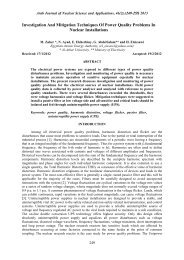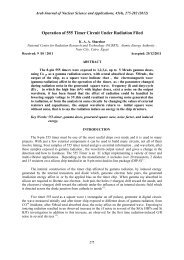Download - Arab Journal of Nuclear Sciences and Applications
Download - Arab Journal of Nuclear Sciences and Applications
Download - Arab Journal of Nuclear Sciences and Applications
Create successful ePaper yourself
Turn your PDF publications into a flip-book with our unique Google optimized e-Paper software.
<strong>Arab</strong> <strong>Journal</strong> <strong>of</strong> <strong>Nuclear</strong> Science <strong>and</strong> <strong>Applications</strong>, 46(1), (282-296)2013<br />
In addition, Tiboni <strong>and</strong> Scott, (37) observed that oral administration <strong>of</strong> fluconazole to pregnant<br />
rats during gestational days 6-17 were associated with several developmental disorders including<br />
limbs defects, ear, rib <strong>and</strong> heart anomalies. Moreover, a loss <strong>of</strong> maternal weight could be a symptom<br />
<strong>of</strong> ill health. This is related to the investigation <strong>of</strong> Jick, (38) who discovered that rats administration<br />
with 40mg/kg <strong>of</strong> fluconazole was related to systemic toxicity which led to loss in weight which is an<br />
index <strong>of</strong> ill health. Fluconazole reaches to the embryonic compartment through placental transfere (39) .<br />
Hence, Khera, (40) , reported that embryo toxicity is known to result in high resorption, fetal death,<br />
fetal body reduction <strong>and</strong> skeletal deformation when fluconazole is administered at high dose (80-320<br />
mg/kg) to pregnant rats. The embryotoxicity induced could be related either to physiological or<br />
maternal homeostasis alterations. Furthermore, the impairment in both maternal gestation <strong>and</strong> fetal<br />
anomalies development could be a consequence <strong>of</strong> inhibition <strong>of</strong> maternal steroidogenesis. (41)<br />
Research studies indicated that the correlation <strong>of</strong> fetotoxicity induced by fluconazole treatment<br />
resulted in increased abnormal crani<strong>of</strong>acial, limbs ossification. These abnormalities may be due to<br />
alterations <strong>of</strong> the pathogenetic pathway <strong>and</strong> interference with cellular <strong>and</strong> molecular mechanisms that<br />
control neural crest cell migration <strong>and</strong> may be causal in the elicitation <strong>of</strong> teratogenic effects (42) .<br />
In the present study, data denoted an increase in (MDA) content in the heart <strong>and</strong> brain tissues <strong>of</strong><br />
pregnant rats. This observation is correlated to the findings <strong>of</strong> Timboni <strong>and</strong> Giampier (43) who stated<br />
that fluconazole has lipophilicity characteristics when combined with low protein bindings which are<br />
responsible for its higher tissue penetration. Brain tissues are very susceptible to oxidative injury<br />
induced by fluconazole treatment. Oxidative stress has been implicated in the pathogenesis <strong>of</strong><br />
ischemic cerebral injury for increasing capacity <strong>of</strong> oxygen consumption <strong>and</strong> high level <strong>of</strong> unsaturated<br />
fatty acid (44) .<br />
Nitric oxide (NO) is a highly reactive molecule which regulates blood flow, augments regional<br />
blood flow <strong>and</strong> vasodilators, <strong>and</strong> improves cerebral circulation. An excess <strong>of</strong> lipid peroxide release<br />
react with NO, disrupting its physiological signalling <strong>and</strong> potentially led to the production <strong>of</strong> other<br />
toxic <strong>and</strong> reactive molecules notably peroxy-nitrite (45) . These led to increase in electrolyte (Na + - K + )<br />
imbalance (cystosolic – calcium levels) resulting in membrane lysis. The relative importance <strong>of</strong> these<br />
effects contributing to clinical myotoxicity <strong>and</strong> elevated lipid peroxidation which led to block ion<br />
channels (46) .<br />
LDH, CPK <strong>and</strong> AST activities are considered as indicators <strong>of</strong> myocardial damage. The present<br />
data showed that LDH, CPK <strong>and</strong> AST activities have been found increased in the serum <strong>of</strong> pregnant<br />
rats. These results are in agreement with Magda <strong>and</strong> Micheal (47) who concluded that the increase in<br />
these enzymes was due to the damage <strong>of</strong> cellular membrane <strong>and</strong> cardiac toxicity.<br />
Radiation exposure produces different lesions in both pregnant mother <strong>and</strong> their fetuses. The<br />
degree <strong>of</strong> lesion depends upon the dose rate <strong>of</strong> radiation, stage <strong>of</strong> pregnancy <strong>and</strong> age <strong>of</strong> animals (48) .<br />
Irradiation <strong>of</strong> mother with 1 Gy on the 6 th day <strong>and</strong> 1 Gy on the 12 th day <strong>of</strong> gestation as practiced in the<br />
present study was found to induce foetal intrauterine death <strong>and</strong> stillbirth together with serious<br />
teratogenic effects in the head, eye, skeletal ossif ication <strong>and</strong> extremities <strong>of</strong> surviving fetuses. Similar<br />
results were observed by Walash (49) <strong>and</strong> Ramadan (22) who reported that total body irradiation <strong>of</strong><br />
pregnant rats induced many malformations in their fetuses during organogenesis period as<br />
exencephaly, haemorrhage <strong>and</strong> low birth weight. This can be due to the direct action <strong>of</strong> radiation on<br />
the embryo <strong>and</strong> placental dysfunction. This view is supported by the work <strong>of</strong> Gaber, (21) who cited that<br />
exposure <strong>of</strong> pregnant rats to gamma irradiation (3 Gy) on the 6 th <strong>and</strong> 12 th days <strong>of</strong> gestation increase the<br />
incidence <strong>of</strong> intrauterine fetal death as well as induce uterine growth retardation.<br />
Moreover, the induction <strong>of</strong> retarded ossification in the skull <strong>and</strong> limbs was correlated with the<br />
reduction in weight <strong>of</strong> fetuses <strong>and</strong> the defect in the eyes, skull <strong>and</strong> nervous system as a result <strong>of</strong> the<br />
sensitivity <strong>of</strong> cells to chromosomal damage which resulted in delays in cell division (50) . The present<br />
293












